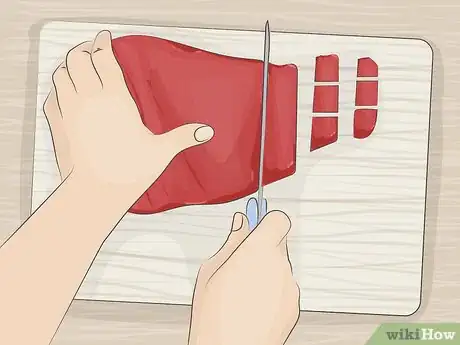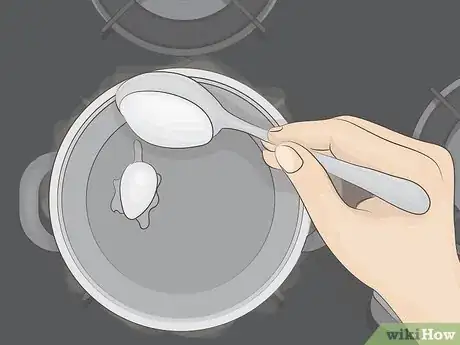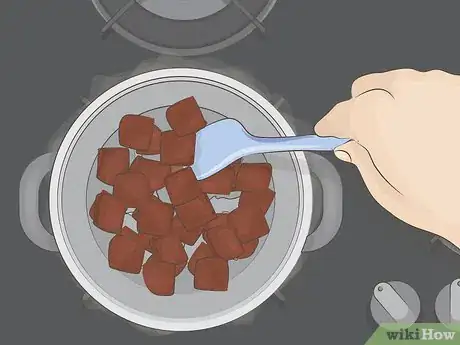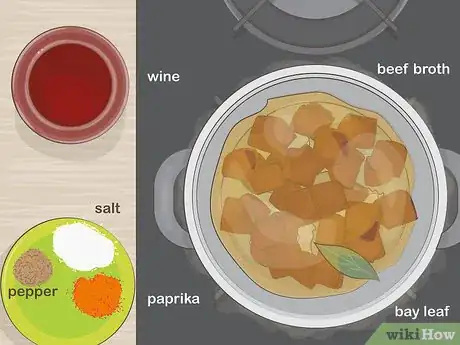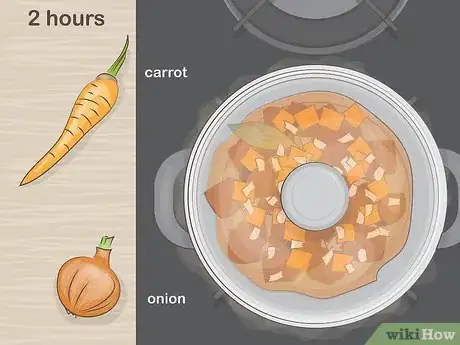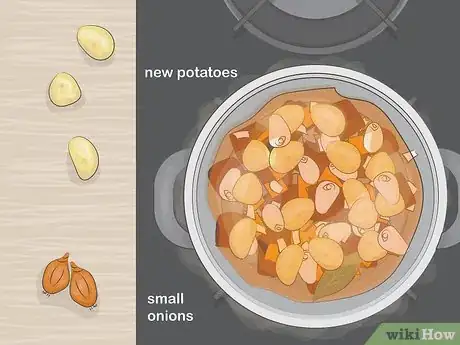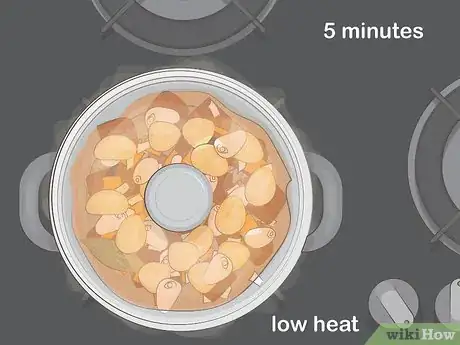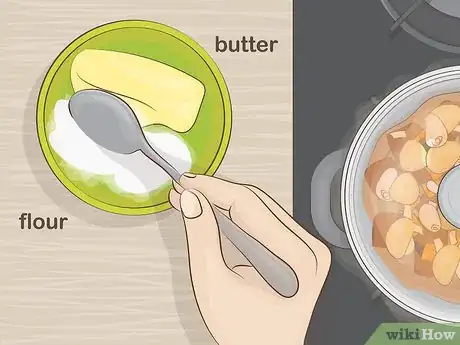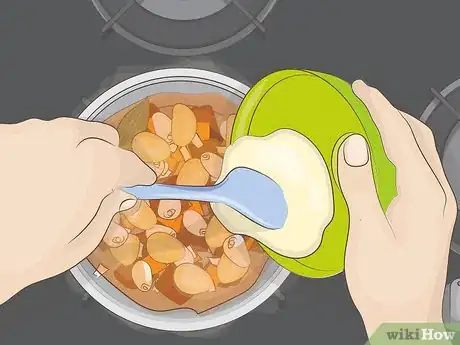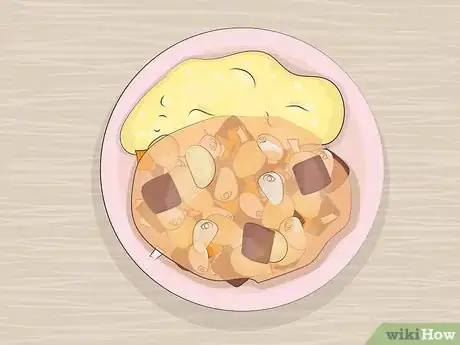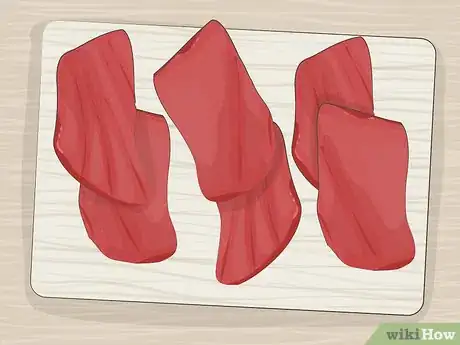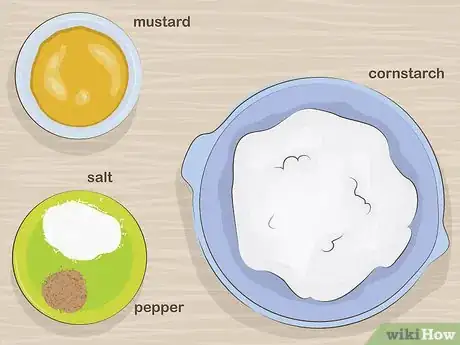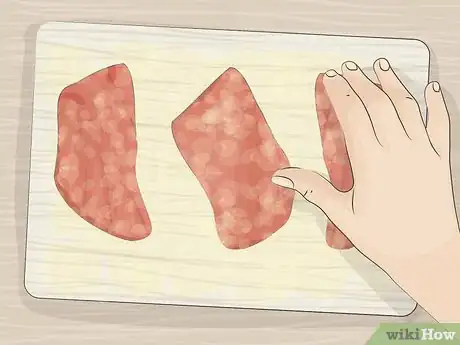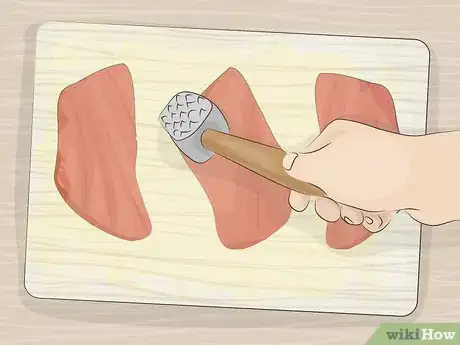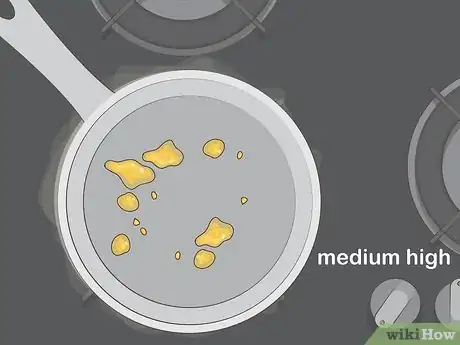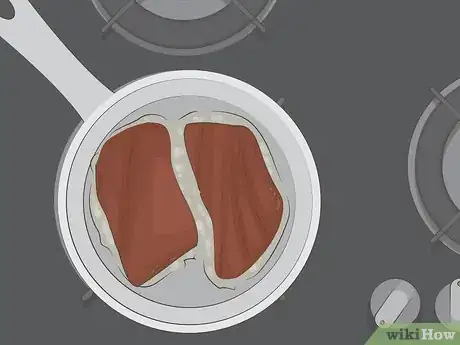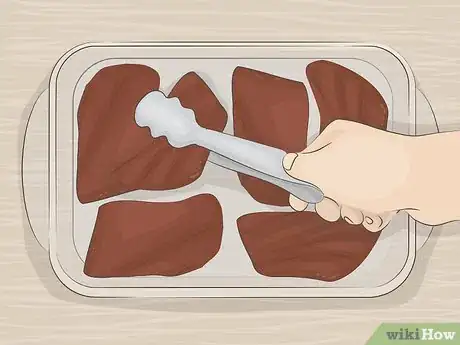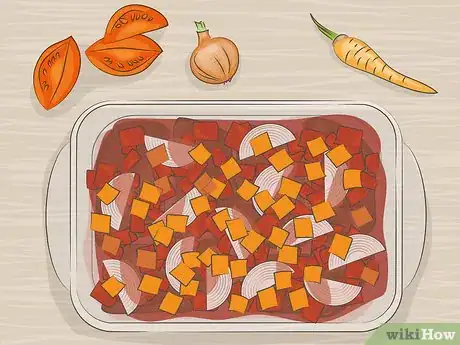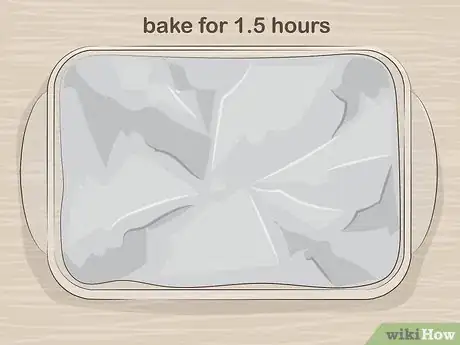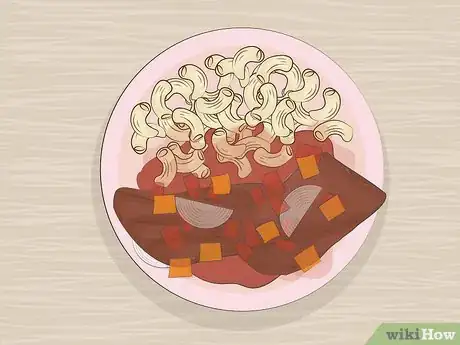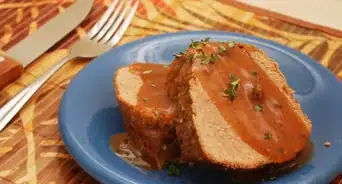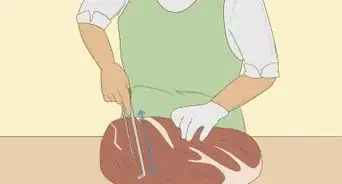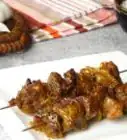This article was co-authored by wikiHow staff writer, Amber Crain. Amber Crain has been a member of wikiHow’s writing staff for the last six years. She graduated from the University of Houston where she majored in Classical Studies and minored in Painting. Before coming to wikiHow, she worked in a variety of industries including marketing, education, and music journalism. She's been a radio DJ for 10+ years and currently DJs a biweekly music program on the award-winning internet radio station DKFM. Her work at wikiHow supports her lifelong passion for learning and her belief that knowledge belongs to anyone who desires to seek it.
This article has been viewed 21,017 times.
Learn more...
If you’re a meat lover, give moose meat a try! It’s much healthier than beef and just as easy to prepare. For something to warm your tummy, try making moose stew. You can also make moose steaks by browning them first and then finishing them in the oven to ensure they get fork-tender.
Ingredients
- 2 ½ lbs (1134 g) moose, cut into 1-inch cubes
- 2 US tbsp (30 ml) of shortening
- 1⁄4 teaspoon (1 g) of cracked black pepper
- 1⁄2 teaspoon (2 g) of paprika
- 1 bay leaf
- 1 teaspoon (4 g) of salt
- 2 (10 1/2 ounce) cans of condensed beef broth
- 1 cup (120 ml) of dry red wine
- 1 large onion, diced
- 3 carrots, sliced
- 18 small whole white onions
- 12 small new potatoes, peeled
- 2 tablespoons (30 g) of butter
- 2 tablespoons (30 g) of flour
Makes 5 to 6 servings
- 1 lb (453 g) of boneless moose steak
- 1/4 cup (30 g) of cornstarch
- 1 tablespoon (14.3 g) of ground mustard
- 1 teaspoon (4 g) of salt
- 1/2 teaspoon (2 g) of pepper
- 2 US tbsp (30 ml) of vegetable oil
- 1 can (14-1/2 ounces) of diced tomatoes, undrained
- 1 medium onion, thinly sliced
- 1 medium carrot, diced
- Hot cooked noodles, optional
Makes 4 to 6 servings
Steps
Making Moose Stew
-
1Cut 2 ½ pounds (1134 g) of moose meat into 1 in (2.5 cm) cubes. Unwrap your packaged raw moose meat and place it on a clean surface. Use a sharp knife to cube the moose meat into bite-sized pieces.[1]
-
2Melt shortening in a large stew pot over medium-high heat. Add 2 US tbsp (30 ml) of shortening to a large stew pot pan. Place the pot on a burner over medium-high heat. Let the shortening heat up until it melts into a liquid.[2]Advertisement
-
3Brown the moose meat cubes. Add the cubes to the stew pot and stir them around continuously in the shortening. Saute the meat cubes until they are brown on all sides.[3]
-
4Add the seasonings, broth, wine, onion, and carrots to the stew pot. Measure out 1⁄4 teaspoon (1 g) of cracked black pepper, 1⁄2 teaspoon (2 g) of paprika, 1 bay leaf, 1 teaspoon (4 g) of salt, 2 (10 1/2 ounce) cans of condensed beef broth, and 1 cup (120 ml) of dry red wine and add them to the pot.[4]
- Stir the ingredients well to disperse the seasonings.
-
5Add the diced onion and carrots and simmer the stew for 2 hours. Use a sharp knife to dice 1 large onion and slice 3 carrots. Add the veggies to the pot. Cover the stew pot and turn down the heat to medium-low and let it simmer.[5]
- Make sure the moose meat is tender after 2 hours. If it’s not, let the stew simmer a little longer.
-
6Add the whole onions and new potatoes to the stew pot. Carefully drop 18 small, whole onions into the stew. Peel 12 small new potatoes with a sharp knife. Add them to the stew, as well. Stir the stew well to disperse the ingredients.[6]
-
7Cover the pot and simmer the stew for 15 minutes. Replace the lid on the pot and keep the heat on medium-low. Let the stew simmer for 15 more minutes until the vegetables start to get tender.[7]
-
8Mix the butter and flour together in a separate bowl. Measure out 2 tablespoons (30 g) of butter and 2 tablespoons (30 g) of all-purpose flour and combine them in a bowl. Keep mixing until the ingredients form a paste-like consistency.
-
9Add the paste to the stew and stir it until the stew thickens. Carefully drop the butter/flour paste into the stew. Stir the stew continuously so the paste melts. It will start to bubble. Keep stirring until the stew thickens.[8]
- Remove the stew from the heat once it reaches your desired consistency.
-
10Serve the stew with cooked rice or polenta. Ladle the moose stew into serving bowls and allow it to cool for 5 minutes or so before serving. Serve the stew with cooked rice or polenta on the side, if desired.[9]
- Refrigerate leftovers in an air-tight container and be sure to consume them within 3 days.
Cooking Moose Steak
-
1Preheat your oven to 350°F (176°C). Let your oven heat up completely while you finish preparing the moose steaks.
-
2Cut your moose steak into serving-size pieces. The size of the steak chunks is up to you. Aim for a thickness of about 1 in (2.5 cm) so all the pieces cook through evenly.[10]
-
3Combine the cornstarch, mustard, salt, and pepper in a bowl. Measure out 1/4 cup (30 g) of cornstarch, 1 tablespoon (14.3 g) of ground mustard, 1 teaspoon (4 g) of salt, and 1/2 teaspoon (2 g) of pepper and add them to a medium-sized bowl. Mix them together thoroughly until the ingredients are fully incorporated.[11]
-
4Rub half of the cornstarch mixture over the steak pieces. Separate the cornstarch mixture into 2 equal portions. Place your moose steaks on a strong, flat surface. Use your hands to rub half of the cornstarch mixture evenly all over the meat pieces.[12]
-
5Pound both sides of the steak pieces with a meat mallet. Pound the pieces until the cornstarch mixture is evenly dispersed. Add the other half of the cornstarch mixture and pound the meat with the mallet for several more minutes.[13]
- Using a meat mallet will tenderize the steaks, since moose meat is notoriously tough.
-
6Heat the vegetable oil in a saute pan over medium-high heat. Measure out 2 US tbsp (30 ml) of vegetable oil. Add it to a large saute pan and place it on a burner. Turn the heat to medium-high. Let the oil heat up until it shimmers.[14]
-
7Brown the steak on all sides in the hot oil. Carefully add the steak pieces to the saute pan. Stir them around continuously until the pieces are browned on all sides.[15]
- If your saute pan is on the small side, you may have to brown the moose meat in batches.
- Remove the meat from the heat once it’s browned.
-
8Transfer the moose steak to a large baking dish. Use tongs to carefully move the browned meat into a large baking dish. Spread the moose meat evenly over the bottom of the dish.[16]
- Try not to allow the meat pieces to overlap much, but a little is okay.
-
9Top the meat with the diced veggies. Pour 1 can (14-1/2 ounces) of diced tomatoes over the meat. Thinly slice 1 medium-sized onion and dice 1 medium-sized carrot. Sprinkle the diced veggies evenly over the meat and tomatoes in the baking dish.[17]
- You don’t need to drain the liquid from the can of tomatoes first.
-
10Cover the dish with aluminum foil and bake the steak for 1.5 hours. You don’t need to stir the dish during this time. After 1.5 hours, check pull out the steak, lift the aluminum foil, and make sure the meat if fork-tender before taking it out.[18]
- If the meat isn’t tender yet, put the dish back into the oven for about 15 minutes.
-
11Serve the moose steak and veggies over noodles, if desired. Separate the meat and veggies into 4 to 6 even portions and plate them. You can serve the dish immediately as is, or you can serve it with cooked noodles.[19]
- Put leftovers in an air-tight container. Refrigerate them for up to 3 days.
Things You’ll Need
Moose Stew
- Sharp knife
- Large stew pot
- Spoon
- Measuring cups
- Measuring spoons
- Small bowl
- Serving bowls
Moose Steak
- Sharp knife
- Bowl
- Spoon
- Meat mallet
- Saute pan
- Large baking dish
- Aluminum foil
References
- ↑ http://www.geniuskitchen.com/recipe/moose-stew-74882
- ↑ http://www.geniuskitchen.com/recipe/moose-stew-74882
- ↑ http://www.geniuskitchen.com/recipe/moose-stew-74882
- ↑ http://www.geniuskitchen.com/recipe/moose-stew-74882
- ↑ http://www.geniuskitchen.com/recipe/moose-stew-74882
- ↑ http://www.geniuskitchen.com/recipe/moose-stew-74882
- ↑ http://www.geniuskitchen.com/recipe/moose-stew-74882
- ↑ http://www.geniuskitchen.com/recipe/moose-stew-74882
- ↑ http://www.geniuskitchen.com/recipe/moose-stew-74882
- ↑ https://www.tasteofhome.com/recipes/moose-steak
- ↑ https://www.tasteofhome.com/recipes/moose-steak
- ↑ https://www.tasteofhome.com/recipes/moose-steak
- ↑ https://www.tasteofhome.com/recipes/moose-steak
- ↑ https://www.tasteofhome.com/recipes/moose-steak
- ↑ https://www.tasteofhome.com/recipes/moose-steak
- ↑ https://www.tasteofhome.com/recipes/moose-steak
- ↑ https://www.tasteofhome.com/recipes/moose-steak
- ↑ https://www.tasteofhome.com/recipes/moose-steak
- ↑ https://www.tasteofhome.com/recipes/moose-steak
